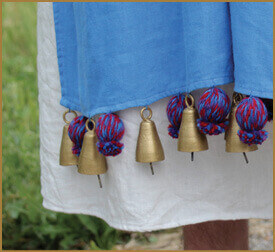Pomegranate
Skillful workers embroidered representations of pomegranates into the hem of the high priest’s robe; the pomegranates were alternated with bells of gold (see Ex. 28:33–34). Additionally, hundreds of images of pomegranates existed on the columns of Solomon’s temple (see 1 Kgs. 7:20; see also 7:18, 42; 2 Chr. 3:16; Jer. 52:22–23).

Pomegranates of blue, purple, and scarlet on the high priest’s robe.
The pomegranate may have three symbolic values: (1) The pomegranate’s calyx (sepals) has the appearance of a crown, which is suggestive of kings, queens, and royalty (queenship/kingship is also associated with the temple). (2) During the spring season, the pomegranate tree is covered with lovely scarlet flowers; scarlet serves as a reminder of the blood of Christ. Similarly, the pomegranate juice is blood red, also an image of Jesus’s blood. (3) The pomegranate’s numerous seeds suggest fertility and eternal increase (granate [from pomegranate] originates from Latin, meaning “having many seeds”).

Pomegranate and seeds; calyx has the appearance of a crown.